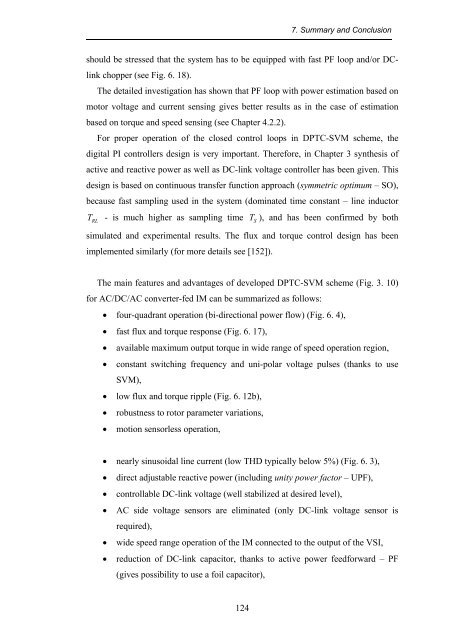Direct Power and Torque Control of AC/DC/AC Converter-Fed ...
Direct Power and Torque Control of AC/DC/AC Converter-Fed ...
Direct Power and Torque Control of AC/DC/AC Converter-Fed ...
You also want an ePaper? Increase the reach of your titles
YUMPU automatically turns print PDFs into web optimized ePapers that Google loves.
7. Summary <strong>and</strong> Conclusion<br />
should be stressed that the system has to be equipped with fast PF loop <strong>and</strong>/or <strong>DC</strong>link<br />
chopper (see Fig. 6. 18).<br />
The detailed investigation has shown that PF loop with power estimation based on<br />
motor voltage <strong>and</strong> current sensing gives better results as in the case <strong>of</strong> estimation<br />
based on torque <strong>and</strong> speed sensing (see Chapter 4.2.2).<br />
For proper operation <strong>of</strong> the closed control loops in DPTC-SVM scheme, the<br />
digital PI controllers design is very important. Therefore, in Chapter 3 synthesis <strong>of</strong><br />
active <strong>and</strong> reactive power as well as <strong>DC</strong>-link voltage controller has been given. This<br />
design is based on continuous transfer function approach (symmetric optimum – SO),<br />
because fast sampling used in the system (dominated time constant – line inductor<br />
T<br />
RL<br />
- is much higher as sampling time T S<br />
), <strong>and</strong> has been confirmed by both<br />
simulated <strong>and</strong> experimental results. The flux <strong>and</strong> torque control design has been<br />
implemented similarly (for more details see [152]).<br />
The main features <strong>and</strong> advantages <strong>of</strong> developed DPTC-SVM scheme (Fig. 3. 10)<br />
for <strong>AC</strong>/<strong>DC</strong>/<strong>AC</strong> converter-fed IM can be summarized as follows:<br />
• four-quadrant operation (bi-directional power flow) (Fig. 6. 4),<br />
• fast flux <strong>and</strong> torque response (Fig. 6. 17),<br />
• available maximum output torque in wide range <strong>of</strong> speed operation region,<br />
• constant switching frequency <strong>and</strong> uni-polar voltage pulses (thanks to use<br />
SVM),<br />
• low flux <strong>and</strong> torque ripple (Fig. 6. 12b),<br />
• robustness to rotor parameter variations,<br />
• motion sensorless operation,<br />
• nearly sinusoidal line current (low THD typically below 5%) (Fig. 6. 3),<br />
• direct adjustable reactive power (including unity power factor – UPF),<br />
• controllable <strong>DC</strong>-link voltage (well stabilized at desired level),<br />
• <strong>AC</strong> side voltage sensors are eliminated (only <strong>DC</strong>-link voltage sensor is<br />
required),<br />
• wide speed range operation <strong>of</strong> the IM connected to the output <strong>of</strong> the VSI,<br />
• reduction <strong>of</strong> <strong>DC</strong>-link capacitor, thanks to active power feedforward – PF<br />
(gives possibility to use a foil capacitor),<br />
124
















![[TCP] Opis układu - Instytut Sterowania i Elektroniki Przemysłowej ...](https://img.yumpu.com/23535443/1/184x260/tcp-opis-ukladu-instytut-sterowania-i-elektroniki-przemyslowej-.jpg?quality=85)
